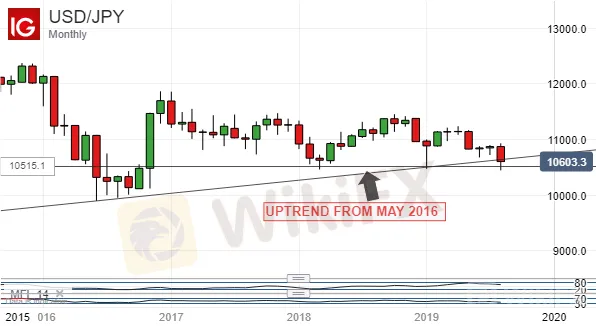简体中文
繁體中文
English
Pусский
日本語
ภาษาไทย
Tiếng Việt
Bahasa Indonesia
Español
हिन्दी
Filippiiniläinen
Français
Deutsch
Português
Türkçe
한국어
العربية
Yen Strength Amid Market Tumult to Keep BOJ Target Out of Reach
Abstract:The Yen‘s traditional haven role has seen it boosted by trade war and recession fears. However, with domestic inflation decelerating again, it’s gains put the Bank of Japan is in a very tricky spot.
Japanese Yen, BoJ Inflation Target, Talking Points:
The Yen has risen as a counter-cyclical haven play
Nothing unusual about that, but it has done so when inflation in Japan was already decelerating
The Bank of Japans official target looks less and less plausible
Find out what retail foreign exchange traders make of the Japanese Yens chances right now at the DailyFX Sentiment Page
The Japanese Yen has played its customary haven role as the financial world frets US-China trade war and bond-market soothsayers seeglobal recession in the yield curve.
Could Yen strengthnow be a headache too far for the Bank of Japan?
The currency has been the closest thing to a fixed point markets get in a shifting and volatile post-crisis landscape. Thats because it is perhaps uniquely immune to economic developments in its home country for one very clear reason; they have no bearing at all on monetary policy.
A strong manufacturing or consumer confidence number in their respective countries, say, may well lift the US Dollar, or the British Pound, as markets place bets that interest rates are more likely to rise as a result.
Not so in Japan. The Bank of Japan has been resolute in its policy stance: no change to extraordinary monetary accommodation until consumer price inflation sustainably hits 2%. Inflation is therefore the only variable which counts.
Japanese Inflation Just Wont Play
The trouble is that, for its part, consumer price inflation has been utterly disinclined to respond.
It‘s been below 2% now since 2015, and in ten years has only topped it for a brief period in that year and the one before. It’s latest showing, for July, was 0.4%. Thats an annualized rate. Prices have been decelerating for four months.
All the while the BoJ has deployed the full armament of stimulus: negative interest rates, control of bond yields and asset purchases to the point where its balance sheet tops Japans entire Gross Domestic Product.
In 2018 BoJ Governor Haruhiko Kuroda said there was a ‘high chance’ that inflation could hit the target this year.
In fact theres no chance.
Officially of course all is well. That 2% inflation target stays and the BoJ insists that is has the tools to hit it.
The reality looks rather different. The target is getting further away, with reports occasionally filtering out of increasing disquiet in banking and academic at the side effects of even trying to hit it.
The US Dollar now looks set to break below an uptrend which has been clear on its monthly chart since May 2016. A sustained bout of Yen strength would see Japanese inflation head even lower, that inflation target look ever-more out of reach.

Disclaimer:
The views in this article only represent the author's personal views, and do not constitute investment advice on this platform. This platform does not guarantee the accuracy, completeness and timeliness of the information in the article, and will not be liable for any loss caused by the use of or reliance on the information in the article.
Read more

Global Market Volatility Amid Central Bank Decisions and Corporate Earnings
The global market is experiencing significant volatility due to uncertainties in economic data and central bank policies. Key highlights include the Nasdaq 100 index's dramatic rise and fall, Amazon's disappointing sales data, and Japan's significant stock market drop following an unexpected rate hike by the Bank of Japan.

Dollar Gains on Hawkish Fed Outlook
After digesting Jerome Powell's comments following the FOMC interest rate decision on Wednesday, the dollar erased all its losses from the soft CPI reading, continuing its upward trajectory. The hawkish outlook from the Fed stimulated dollar strength against its peers, while the bullish momentum in equity markets was hindered by the prospect of prolonged high interest rates.

USDJPY Predicted to Rise on Yen Depreciation
The USD/JPY pair is predicted to increase based on both fundamental and technical analyses. Fundamental factors include a potential easing of aggressive bond buying by the Bank of Japan (BoJ), which could lead to yen depreciation. Technical indicators suggest a continuing uptrend, with the possibility of a correction once the price reaches the 157.7 to 160 range.

Relationship Between Abe and Japanese Yen
Shinzo Abe, the longest-serving Japanese Prime Minister in history, has suddenly resigned on August 28, citing health reasons.
WikiFX Broker
Latest News
Why Are Financial Firms Adopting Stablecoins to Enhance Services and Stability?
Experienced Forex Traders Usually Do This Before Making a Lot of Money
Octa vs XM:Face-Off: A Detailed Comparison
When High Returns Go Wrong: How a Finance Manager Lost RM364,000
Bridging Trust, Exploring Best—WikiEXPO Hong Kong 2025 Wraps Up Spectacularly
Fidelity Investments Explores Stablecoin Innovation in Digital Assets Sector
Interactive Brokers Expands Crypto Trading with Solana, XRP, Cardano, and Dogecoin
SEC Ends Crypto.com Probe, No Action Taken by Regulator
Why More People Are Trading Online Today?
Broker Comparison: FXTM vs XM
Currency Calculator







